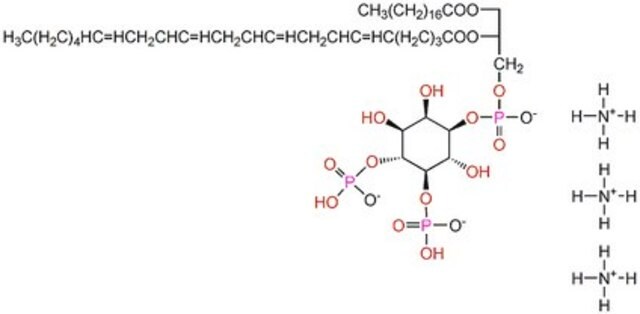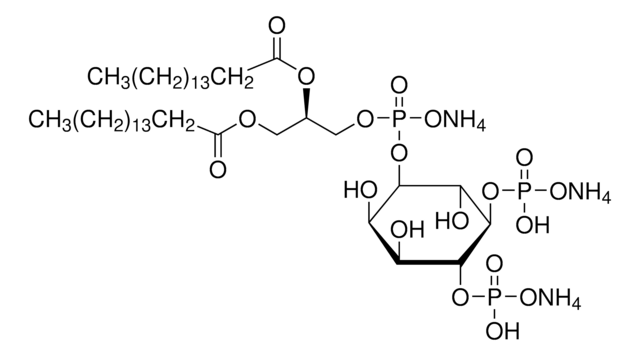850165P
Avanti
18:0-20:4 PI(4,5)P2
1-stearoyl-2-arachidonoyl-sn-glycero-3-phospho-(1′-myo-inositol-4′,5′-bisphosphate) (ammonium salt), powder
Sinónimos:
1-octadecanoyl-2-(5Z,8Z,11Z,14Z-eicosatetraenoyl)-sn-glycero-3-[phosphoinositol-4,5-bisphosphate] (ammonium salt); PIP2[4′,5′](18:0/20:4(5Z,8Z,11Z,14Z))
About This Item
Productos recomendados
Ensayo
>99% (TLC)
Formulario
powder
envase
pkg of 1 × 100 μg (with stopper and crimp cap (850165P-100ug))
pkg of 1 × 500 μg (with stopper and crimp cap (850165P-500ug))
fabricante / nombre comercial
Avanti Research™ - A Croda Brand 850165P
tipo de lípido
cardiolipins
phospholipids
Condiciones de envío
dry ice
temp. de almacenamiento
−20°C
cadena SMILES
[H][C@@](COP([O-])(O[C@H]1[C@H](O)[C@@H](OP(O)([O-])=O)[C@H](OP([O-])(O)=O)[C@@H](O)[C@H]1O)=O)(OC(CCC/C=C\C/C=C\C/C=C\C/C=C\CCCCC)=O)COC(CCCCCCCCCCCCCCCCC)=O.[NH4+].[NH4+].[NH4+]
Clave InChI
GAIOWTITBYPFJE-WGJQOQIESA-N
Descripción general
Aplicación
- in cryo-electron microscopy (cryo-EM) grid preparation
- in host 1-O-1-(Z)-octadecenyl-2-arachidonoyl-sn-glycero-3-phosphocholine (plasmenyl-SAPC) small unilamellar vesicles (SUVs) in the presence of H2O2 to activate cyt c plasmalogenase activity
- to study whether acyl chain types affect phosphatidylinositol 4,5-bisphosphate (PIP2) cluster formation
Envase
Información legal
Código de clase de almacenamiento
11 - Combustible Solids
Elija entre una de las versiones más recientes:
Certificados de análisis (COA)
It looks like we've run into a problem, but you can still download Certificates of Analysis from our Documentos section.
Si necesita más asistencia, póngase en contacto con Atención al cliente
¿Ya tiene este producto?
Encuentre la documentación para los productos que ha comprado recientemente en la Biblioteca de documentos.
Los clientes también vieron
Global Trade Item Number
| Número de referencia del producto (SKU) | GTIN |
|---|---|
| 850165P-100UG | 4061835227167 |
| 850165P-1MG | 4065270903457 |
| 850165P-500UG | 4061835227174 |
| 850165P-5MG | 4065270903464 |
Nuestro equipo de científicos tiene experiencia en todas las áreas de investigación: Ciencias de la vida, Ciencia de los materiales, Síntesis química, Cromatografía, Analítica y muchas otras.
Póngase en contacto con el Servicio técnico













